Germany - Unveiling Our True Thoughts and More: Two Weeks of Adventure in Bavaria
- karenconnolly59
- Jul 18
- 26 min read
"The world is a book and those who do not travel read only one page"

Our travels in the past have taken us from the UK to tour 10 countries in 21 days so for this tour we wanted to focus on one country in particular, Germany 🇩🇪.
Germany is often a country we travel through to get somewhere else but it has a charm and beauty in its own right that should not be ignored and so this June we focussed on the southern part namely Bavaria the largest Federal State in Germany.
Planning for our trip is pretty straight forward as we have been to Europe a few times now but if this is your first time there are a few things you need to be aware of and so should read our post here that describes how to plan to get the best of your trip to Europe.
Our tour included travelling in our Ineos Grenadier 4x4, sleeping in the car and either wild camping or using campsites along the way. The only two fixed points in our trip are the ferry crossing into France and the return journey with everything in between being flexible. If you are taking your house on wheels or plan to stay in Airbnb's our 15 day itinerary is a good place to start.
It sounds daft but Germany is huge and so how much you can cover in 2 weeks driving from the UK is limited and with all the travel sites telling you the 'must dos' we can guarantee you won't be able to see them all in 2 weeks. Our advice is take your time, enjoy the journey and where possible limit your time on the autobahns. Driving from place to place is part of your tour but the trick is not feeling like you have to get to a certain instagram worthy place and miss the other often unmentioned places along the way.
So here we go Germany - Unveiling Our True Thoughts and More: Two Weeks of Adventure in Bavaria
This is a blog where we share with you our honest opinions of the places we visited and if we think it's worth a visit or not and possible places you could visit if you have more time.
Day 1 Leaving the UK to take the Ferry to Dunkirk
We chose to travel to Dover to take the ferry to Dunkirk namely because this was the cheapest way to cross the channel. Leaving Cheshire at 4am we made our way south to catch the 10am ferry. The beauty with the ferry is that if you arrive 4 hours either side of the departure time you can still travel on your ticket.

We chose to travel to Dunkirk as we love Bruges in Belgium and stop off here for a few hours before we find our bnb also in Belgium. We always stay the first night in an Airbnb so we can have a good nights sleep before we carry on our onward journey on Day 2. We sleep really well in our Grenadier but finding a camping spot, making the bed and sorting out the bags after being up since 2am is not the best for us, we want a bit of pampering 😀
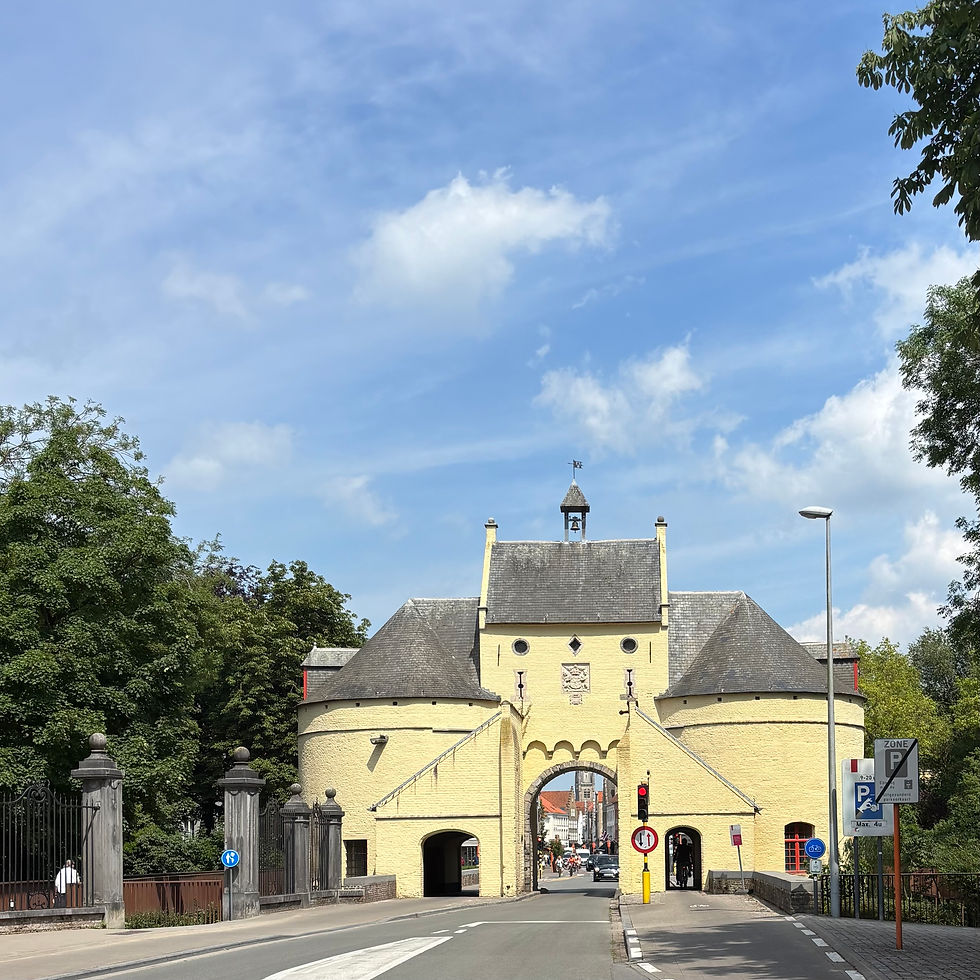

The drive to Bruge is only an hour from Dunkirk where we have a favourite free parking spot on the outskirts of the town and walk in to our favourite city. The attractions here mean you could spend a few days easily but as a simple stop off we head straight to Otto Waffle Attelier and buy the best vegan waffles ever! We get them loaded with caramel sauce, nuts vanilla ice cream strawberries and blueberries. A sublime taste sensation!



If you are visiting Bruges for the first time then definitely book a walking tour as these are usually fun and very informative. We can still remember some of the facts we were told the first time we visited.


We have stayed in a few different bnb's in Belgium all of which have been excellent. This time we stayed in The Bee Garden in Lege and it was superb. It cost us £72.46 through Airbnb but you can book directly through their website www.thebeegarden.be
If you want to see our walk through video you can always check out our instagram account on @2ontourexplore
Day 2 Leaving Lede and visiting Namur Citadel.
Namur Citadel is still in Belgium but worth a visit to explore the old town of Namur or the Citadel (Fortress) high on the hill at the site of the confluence of the Sambre and Meuse rivers. There are a series of tunnels below the citadel which can be explored or you can sit at the top and enjoy an alfresco lunch watching the cable cars arrive to drop off visitors. Napoleon called this the Termite of Europe due to the tunnels but it dates back to the roman era. Each successive ruler from the Holy Roman Empire to the french and then the dutch extended the township. It was only when Belgium gained independence in 1830 that it became the residence of King Leopold I. The last soldiers left in 1977 after which it became a tourist attraction and can be reached today by car, cable car or tourist train. www.citadelle.namur.be


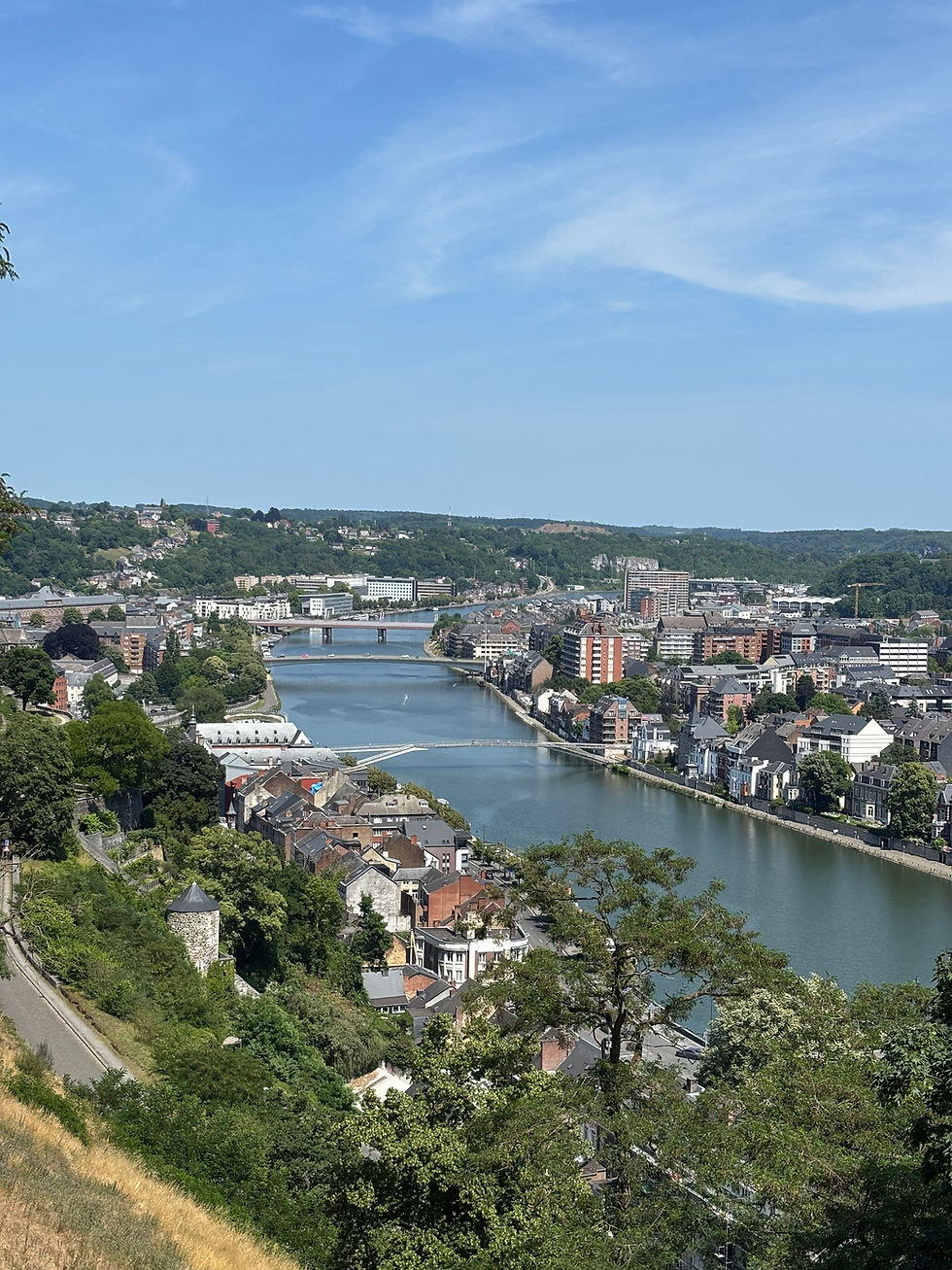


Our journey took us through Luxumboug into Germany where we found a great park up for the night on Park4Night [(Germany 54332) Wasserliesch]. This was above the Moselle River through a village with nice hiking trails and an orchid path. There are no facilities here and it is mainly used by dog walkers but there is a picnic table and rubbish bin and provided you leave no trace everyone is happy.







Day 3 Drive to Rhineland Palatinate
Today was mainly about continuing our transfer to Bavaria. The plan was to drive to find a campsite and the explore on Day 4 particularly the Rhine Gorge.
Finding a campsite in this area was not as easy as we thought. It wasn't that there were no campsites it was more about the quality of the site. We wanted a shower now otherwise we would have freedom camped but the 30 degree heat was limiting our days without facilities!
Some campsites were like battery chickens and that for us was a big NO. Time was getting on and we found a campsite called Camping Moosaibtal. This was 23 euros per night and after we were given a spot at the farthest point near to the river we opted to stay 2 nights.
There were a lot of permanent residences on the site and we found out this was also school holidays however, it was clean and the site owner was very friendly and helpful. I think had we been closer to reception we would not have enjoyed this site as much so if you do stay here try and ask for the lower field.

Day 4 Bingen and Mainz
Today was the day to drive along the Rhine Gorge also called the Romantic Rhine which started further north at Bingen. We did stop at Bingen but to be honest it didnt wow us and so after a quick walk around we left to make our way to Mainz then down the Gorge. This was one of those days that ended with frustration as Mainz was like London on steroids. We couldn't park anywhere and there were so many road closures and road works we gave up in the end. This was one of those days we decided to return to the campsite and chill. It is days like this that the journey does not feel like part of the tour!

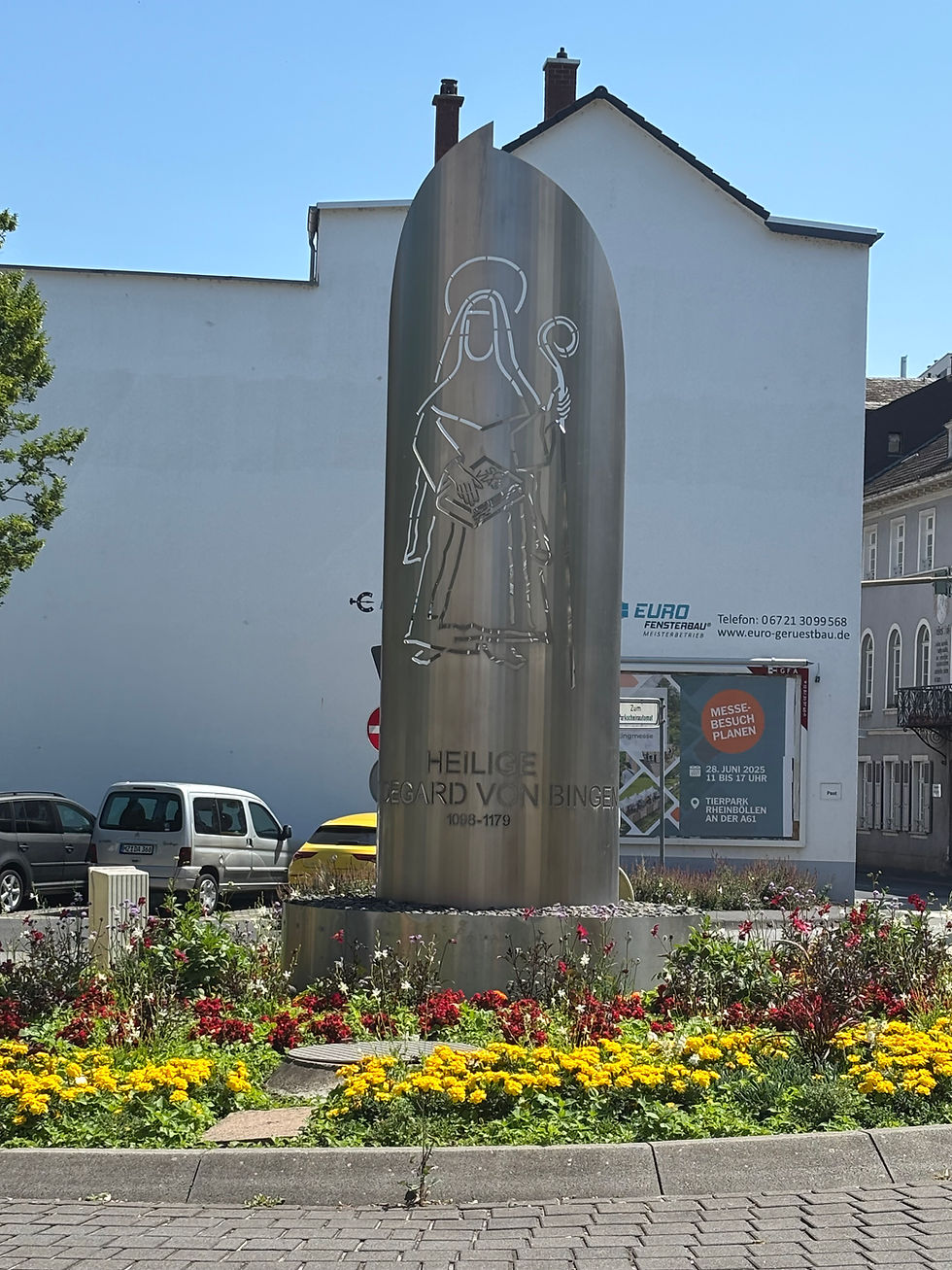

However, if you are taking this trip then our advice would be to start about 40Km south of Mainz to pick up the gorge and travel through this UNESCO World heritage Site. There are an abundance of medieval castles and the steep walls of the gorge are covered in vineyards. There is so much to do here including a cruise down the Rhine, hiking trails, sightseeing the castles or even wine tasting. We will add this to our must do's as we will definitely be back.
Day 5 The Black Forest
Today felt like the start of our real insight into Germany's charm and beauty. Don't get me wrong we had travelled through beautiful countryside but we felt we had missed out on what Germany had to offer mainly because we didn't get to where we wanted yesterday and also travelling a lot on the autobahn.


We drove through Seebach a gorgeous little town with its quirky telephone boxes, the forests and arrived in the hills to the Allerheiligen Waterfall carpark. It was a great drive up through winding roads with gorgeous views but as it was getting late to climb the waterfall and set up camp we thought we would start our walk early tomorrow.

We thought we would freedom camp in the car park which was busy when we stopped and there were a couple of campervans. However, as it got late the car park completely emptied leaving just us with no mobile signal and feeling a little vulnerable just on our own we decided to move on where there was at least a signal. We don't mind being off grid but would prefer it when there are others nearby just in case...

We decided to continue into Oppenau a picturesque village and camped in a campsite at Bad Petersal. We booked 2 nights as we definitely wanted to go back up to the waterfall so we paid 18 euro/night plus showers and pitched up. Our evening meal was under the stars as it got so late.


Day 6 Allerheiligen Waterfall
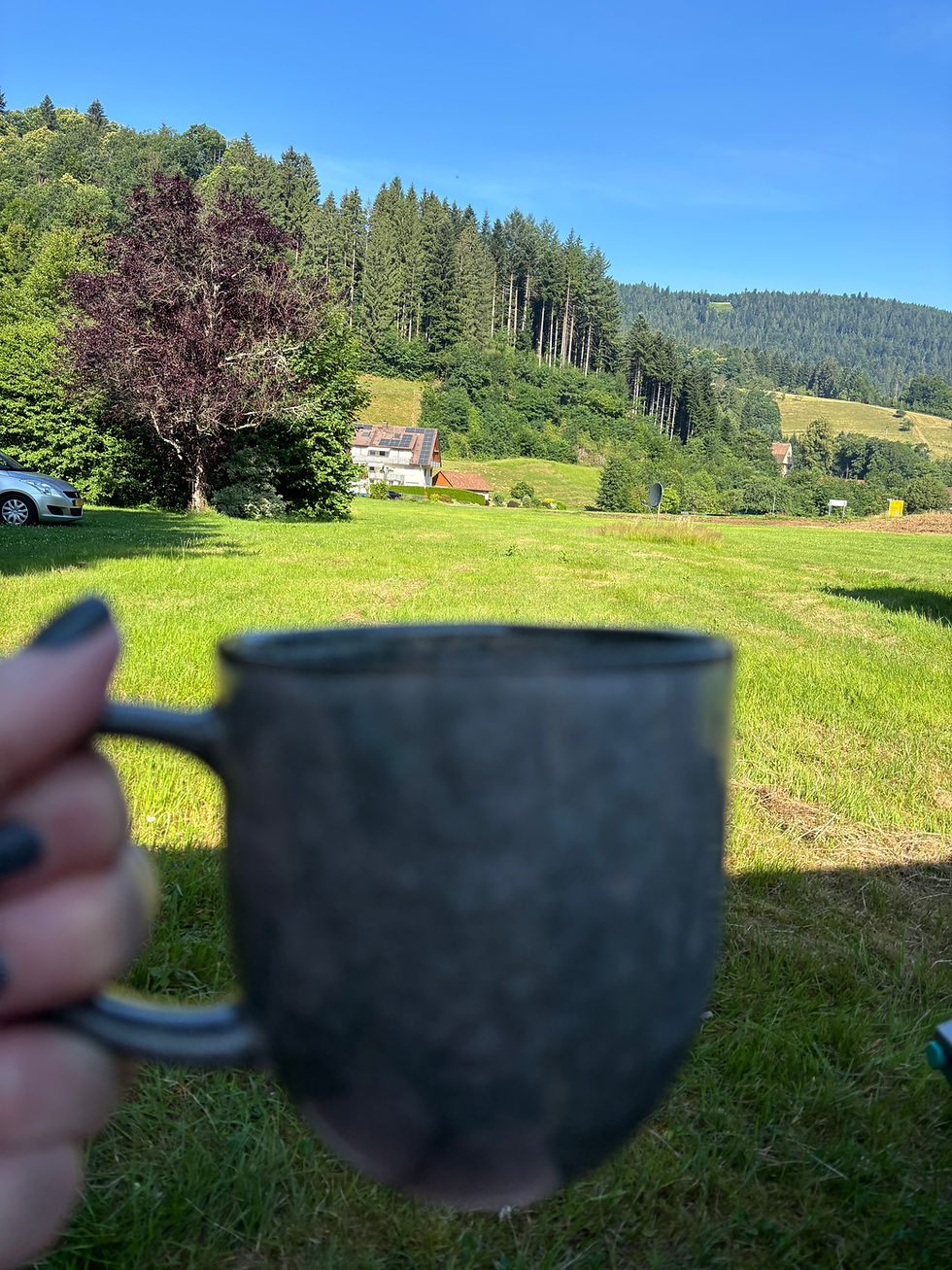
After we started our day with coffee we set off back again to Allerheiligan and found this great roadside vending machine full of fruit, cheese, eggs and meat. Fab idea and top quality.
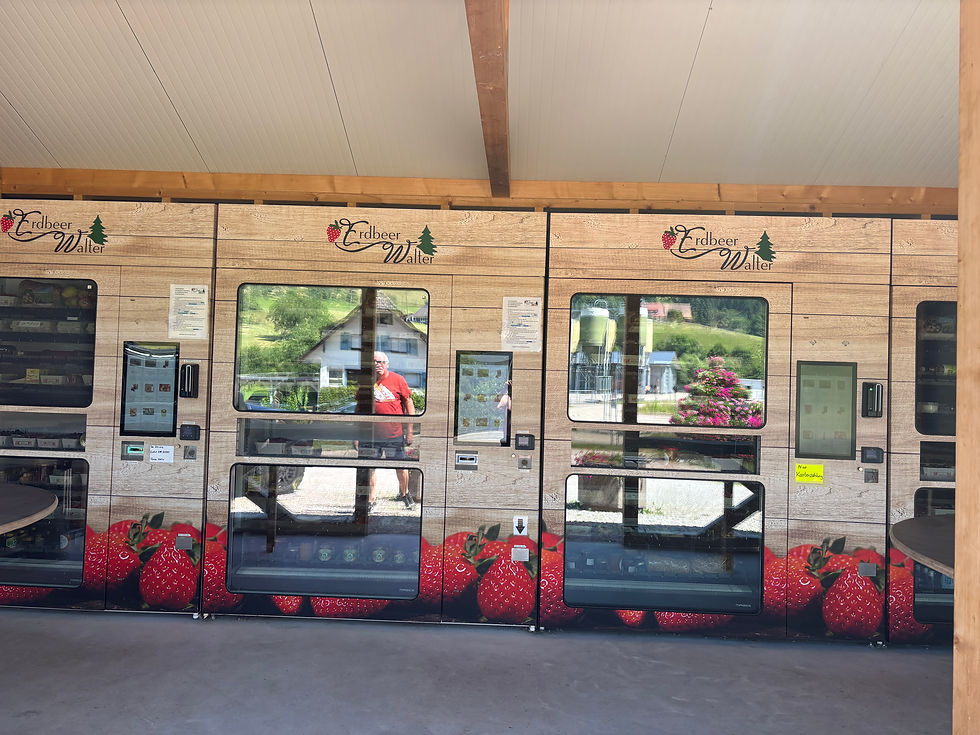

Today the car park was full to bursting and so we parked on the grass verge with others and began to climb up the Allerheiligen Waterfall.

There were 240 steps up to the top plus the path inclines to see the cascading Lierbach Stream cascading down 7 levels a total of 83m




After you reach the top tier the path continues until you reach a collection of buildings one of which are the ruins of the All Saints Abbey together with a museum and a couple of cafe/restaurants. The Abbey was originally a monastery founded in 1191 to 1196 and became a site for pilgrims in the 13th century. Over the next few hundred yeard it was enlarged until it became an Abbey in 1657. The Abbey was blighted by fires and lightening and so the monks left in 1803 with it being planned for demolishen in 1816. The ruins of the Abbey provided a backdrop and used to 'own' the waterfall as part of the monastery. The waterfalls remained hidden until the early 19th Century when they were discovered with the aid of ladders. The German Forestery Commission installed the steps, paths and bridges in 1840 and due to the volume of visitors they need regularly renovating.



In the heat of the day you can be refreshed by a cold beer or german wine and food. This was a great walk and very popular at the weekend but you still felt you could take your time, enjoy the views or even picnic by the river.


After the walk we drove back down the mountain to Oppenau and sat enjoying beer and ice cream watching the world go by for a couple of hours. Sometimes its the simple pleasures which are the best.





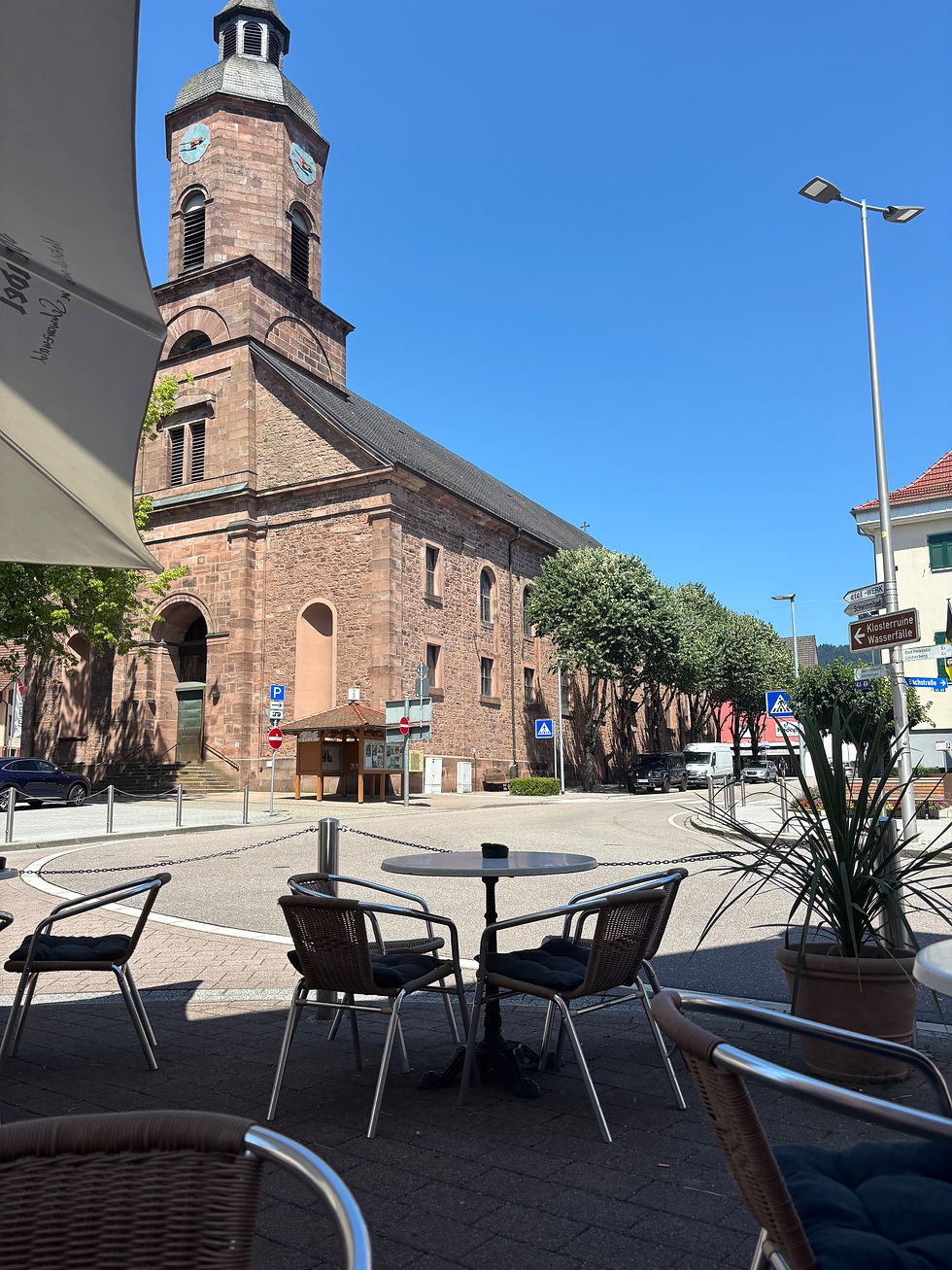

Day 7 Lake Constance, Meersburg and Lindau
Lake Constance or Bodensee (german) is huge and borders the three countries of Germany, Austria and Switzerland. There are numerous villages and towns along the shoreline each with their own charm. We had seen Lindau was a place to go so that was our plan however, we saw that Meersburg from a post on instagram from the German Tourist Board was one of the prettiest towns to visit so we thought we would start there.

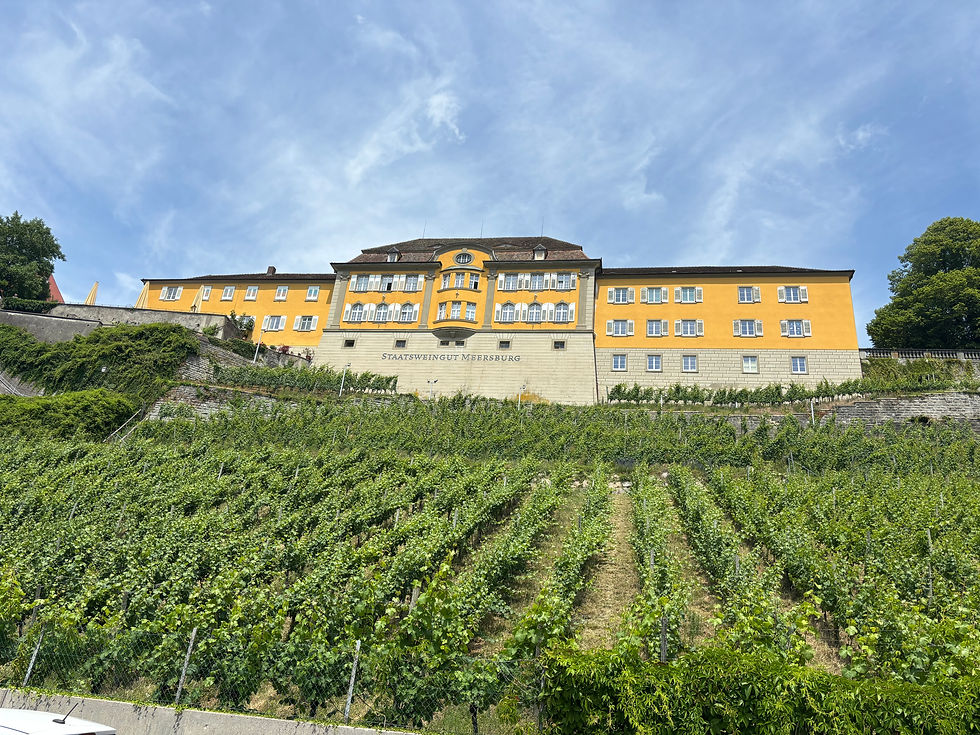
We approached the lake along the north shore arriving at Meersburg first. As we parked up near the lake we could hear singing from the nearby college and the medieval buildings were gorgeous. This place had not previously been on our wish list but we would highly recommend it even though it appears to be a tourist hotspot and has over 1 million visitors per year. There were lots of street cafes and in general people enjoying the good weather food and drink. Some of the streets were steep to walk up but worth it to see the buildings all huddled together. There is plenty to see with the old medieval castle (possibly dating back to the 7th Century) and the 'new' palace of the Prince-Bishops built in the 1700's. The Prince Bishop at the time is a combination of a religious and worldly leader and held a special place in the Holy Roman Empire. Meersburg became the property of the Bishops of Konstanz in the 13th Century. A small town was developed which meant they could then hold a market. In the Napoleonic era the Prince Bishops were removed and the town became part of Baden. This loss of power had a distasterous impact on the economy and didnt recover until tourism took over in the 19th century especially with the introduction of the ferry service.
The vineyards were originally owned by the Prince Bishops of Konstanz but then became owned by the state of Baden-Wurttenberg. There are some private vineyards too where Schnapps is made and there are a couple of annual festivals purely to do with wine making.
The is a museum totally dedicated to the history of viticulture located in the upper town which we didnt get time to visit.


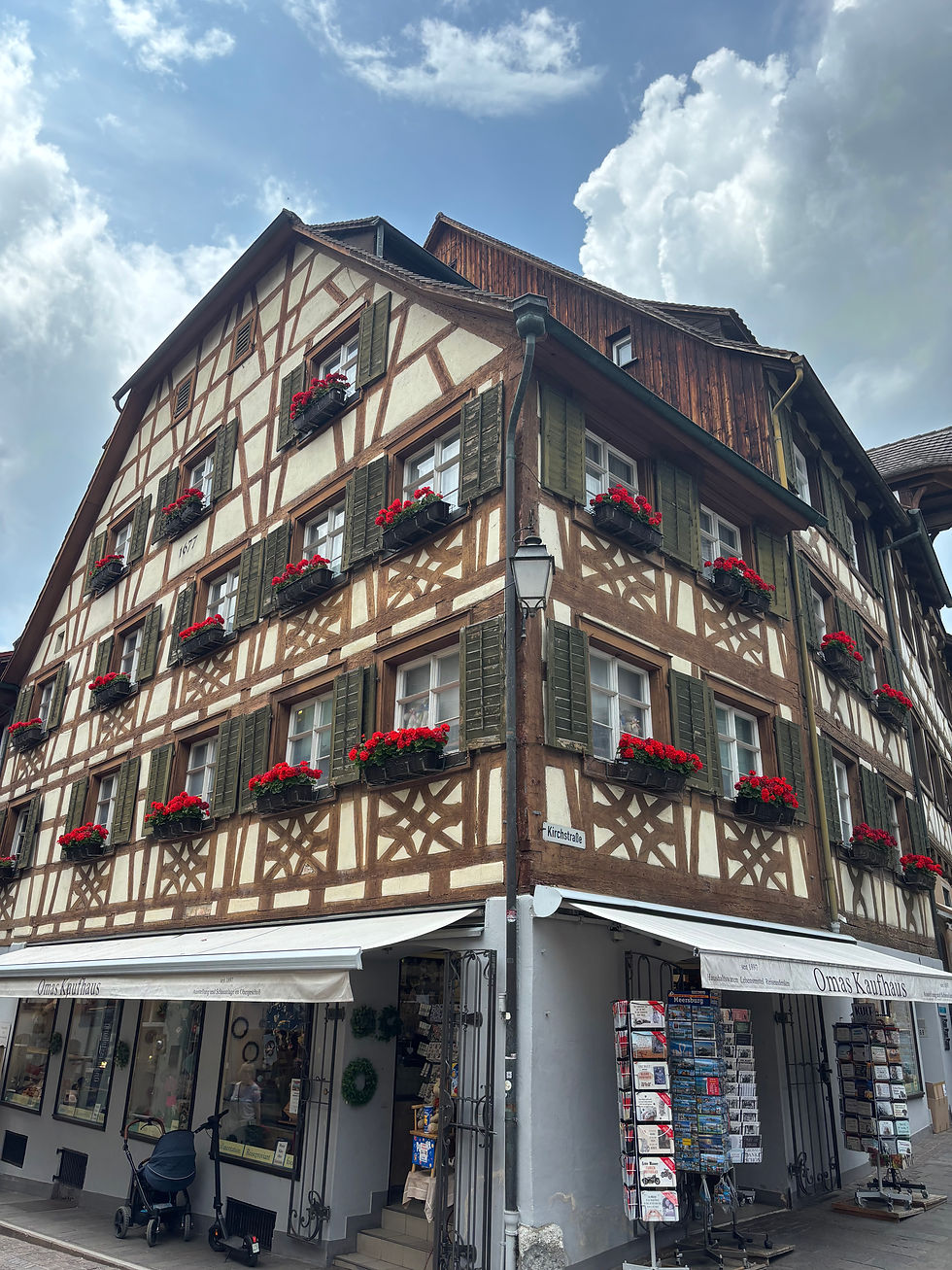


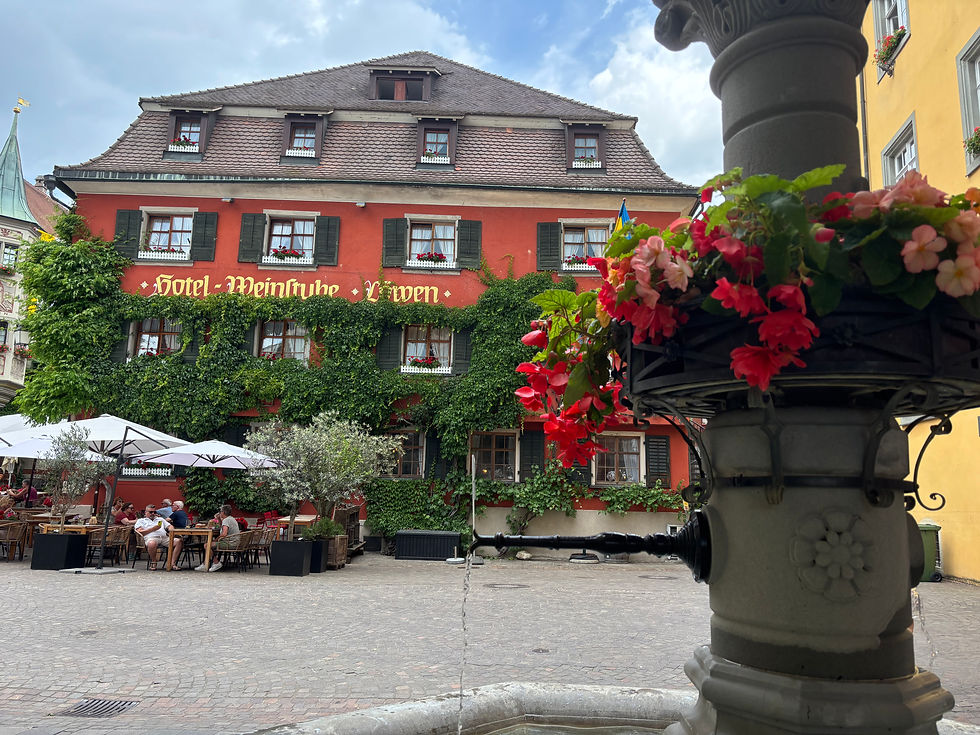
Further around the lake we visited Lindau a medieval harbour town situated on an island in Lake Constance. We didn't really feel the charm that is boasted about on the internet but it still has its fair share of medieval buildings and history and lovely gardens. We walked around the harbour to see the famous light house and lion guarding the entrance and saw the Old Town Hall building and train station. If you have limited time we would recommend spending longer at Meersburg and skipping Lindau altogether.

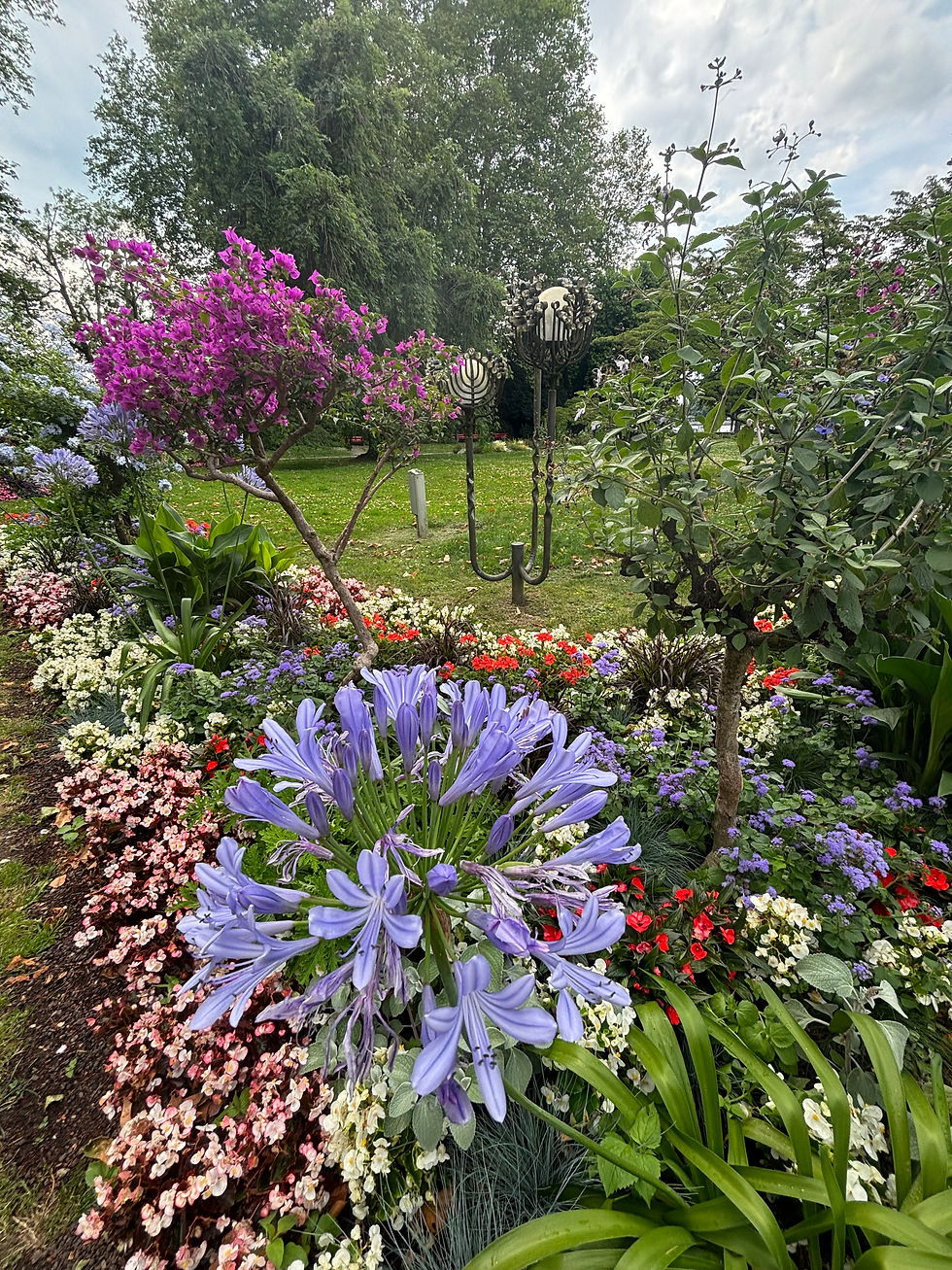







Our park up for the night was in the hills above the town of Lindau in a parking spot for hikers (Park4Night 88131). For most of the night there was just us but after dark we were joined by one other campervan. There were again nearby walks you could do but no facilities so you really need to be self sufficient and leave no trace.


Day 8 Garmisch-Partenkirchen, Zugspitze
The drive out of the Black Forest closer to the Alps was stunning as the mountains came into view.


We had booked to scale the summit of Zugspitze the highest mountain in Germany at 2962m.
This trip can start in a couple of places and we chose to start at the train station in Garmisch-Partenkirchen. You can park at the main train station for 7 euros per 24 hours, be sure to take coins though for the machine. You walk through the tunnel on platform 1 in the main station and on the other side see the Zugspitze station as this was once an olympic village. Your round ticket includes a train journey, a cogwheel train journey and finally the cable cars to the summit. The website is a little confusing so we just followed the other people as it wasn't clear where you got on and off the trains etc. The transport cost 75 euro/person for the day but if you wanted you could drive part way and just pay for the cable car. Today we were glad to not spend the day driving and let others take the reins.

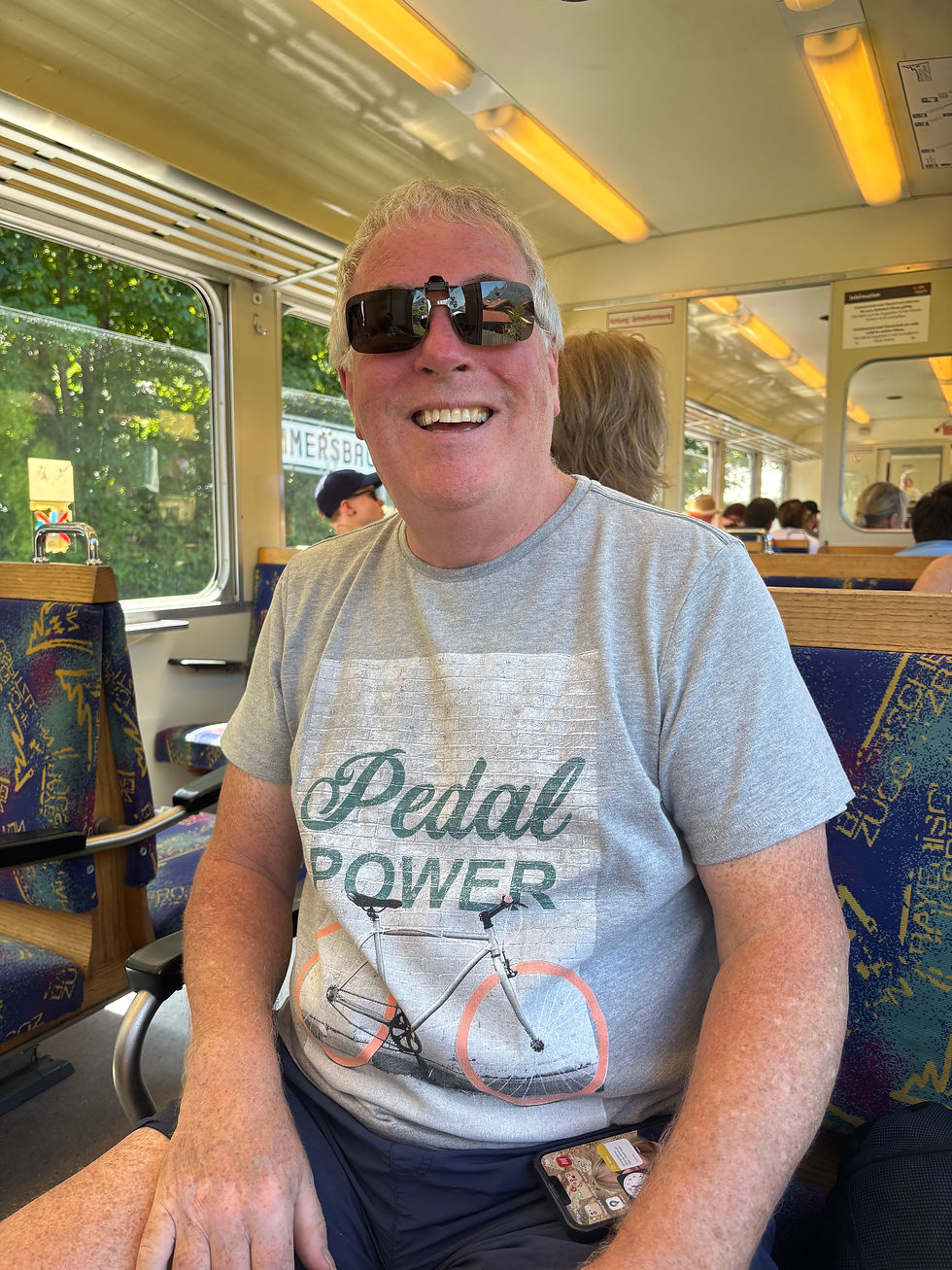
The easiest way we found was to start at the main station in Garmisch-Partenkirchen and take the 90 year old cogwheel train to the plateau of Zugspitze. You then take the 1,000m Gletscherbahn cable car to the summit. The views from the plateau are amazing with glaciers, glacial lakes and being able to look out to Austria and Germany. On the plateau is also the Maria Heimsuchung Chapel (Chapel of the Visitation of Mary) the highest church in Germany at 2650m





The views from the plateau and the summit were stunning and being able to walk 360 degrees around the summit and see the glaciers was incredible. There are two glaciers one of which has been declassified now as the rate of shrinkage is quicker than the growth from the annual snowfall. These are the last glaciers in Germany and are being lost through climate change. You have a clear view of Lake Eibsee from the top too, another cool place to visit on your way down descending on the world record breaking cable car. The cable car has 3 world records in that it has the highest steel support at 127m, there is an altitude difference of 2km between the mountain and the valley and finally the longest freely suspended section of rope in the world at 3.2km. (Info courtesy of www.Zugspitze.de)






At the summit you can look across to 4 countries (Germany, Austria, Switzerland and Italy with over 400 mountain peaks) but you can physically straddle the border between Austria and Germany. Before the formation of the European Union you would need your passport stamping moving from one side to the other also changing your currency from schillings to marks. The lifts from both countries meet at the summit but it was the Austrians who built the first cable car and later in 1931 the Germans built the cog railway to the plateau and subsequently a cable car to the summit. The walk way which connects the two countries used to be the border station and now either side is represented by regional flags rather than national flags.
The Austrian side of the summit was originally higher than the German side until the Germans blew the top off in WWII to make a flak tower to shoot at enemy airplanes. Now the summit is used by both countries for communication purposes either for air traffic control or civil defense back in the cold war years.


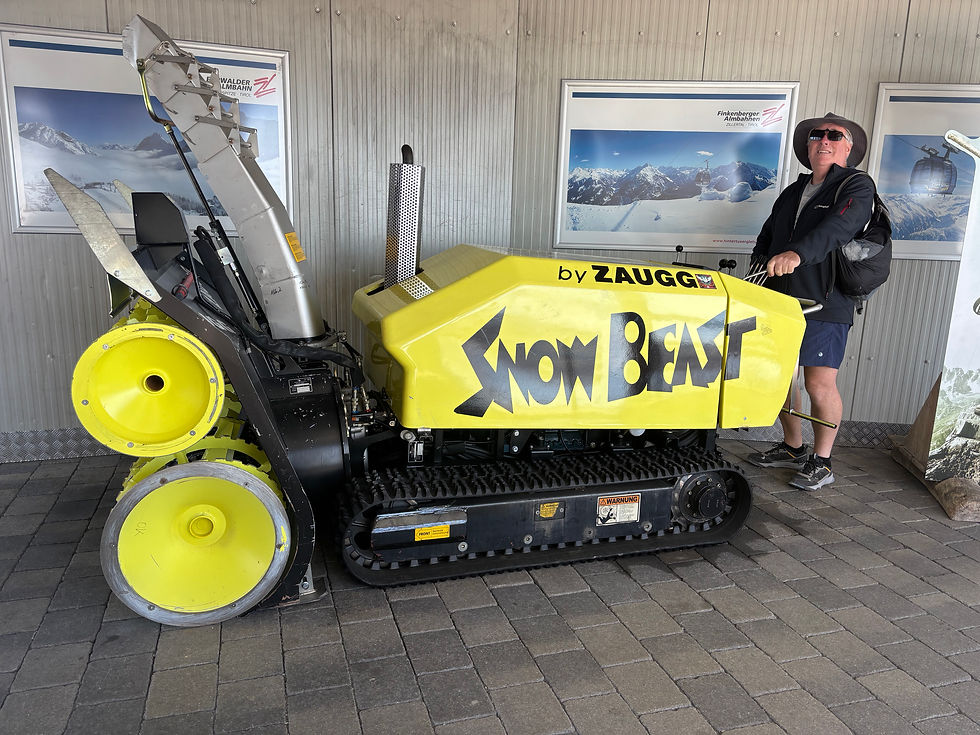
Now one of the challenges at the summit is to climb the last part to the summit cross. This challenge is very popular and involves clambering up the rocks with guide wires to hold on to. It was really tempting to do this but in truth was just one step too far for us. For younger more sure footed guys it was a great achievement. We were happy to look and cheer them on. The cross marks the highest point in Germany and the original one was hauled up to this point by a priest and his friends in 1851. The one you see today is not the original one as this was used for target practice by the Americans in 1940.

Before descending you can be refreshed in either the Panorama Resturant, the Gletscher 2600 which is completelly vegetarian and vegan or the Sonnalpin Glacier Restaurant. Most of the restaurants close at 4pm though so if you want food you need to choose before this time. You can still order a drink though from the bar. We opted for a local beer and an Aperol Spritz which was a first time experience. To be honest it wasn't my bag I would rather have had the beer but it's one I've chalked up to experience. The colour in the glass though looked amazing against the blue sky!



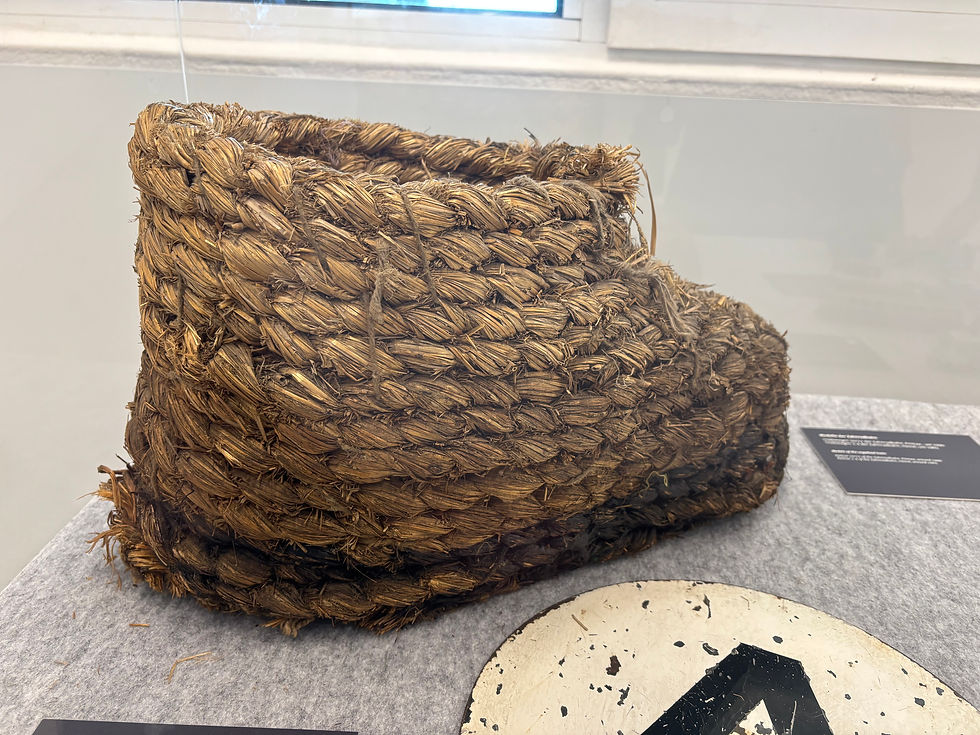



On the way down from Zugspitze you can take the cable car and stop off at Lake Eibsee a beautiful clear green turquoise lake. This is a very popular spot with tourists and you will find places to paddle/swim and canoe.
You can also walk around the perimeter which is approx 7km, a fairly easy walk for 1.5-2 hours but are not allowed to camp in any form as the lake is privately owned. There is a car park which fills up fairly early and must be empty by 2200 hours or you are fined but in our opinion if you are staying in the region you get a guest pass for the buses which are great and make life a lot easier. It was really hot on the day we were there (>30 C)and so walking around the lake for us was not an option but I would definitely recommed doing this earlier in the day before the midday sun.

This area is very popular and with that comes and expensive price tag for accommodation We booked the Hotel Garni onthe outskirts of town at a cost £112 per night which to be honest was overpriced. The owner was lovely and the views from the breakfast terrace stunning but the rooms are very basic with no tea and coffee and no fans to cool the room which was still 25 degrees at night. From outside the hotel we could see the remains of the ski jump from the 1936 winter olympics and with the sunsetting in the background it looked gorgeous.
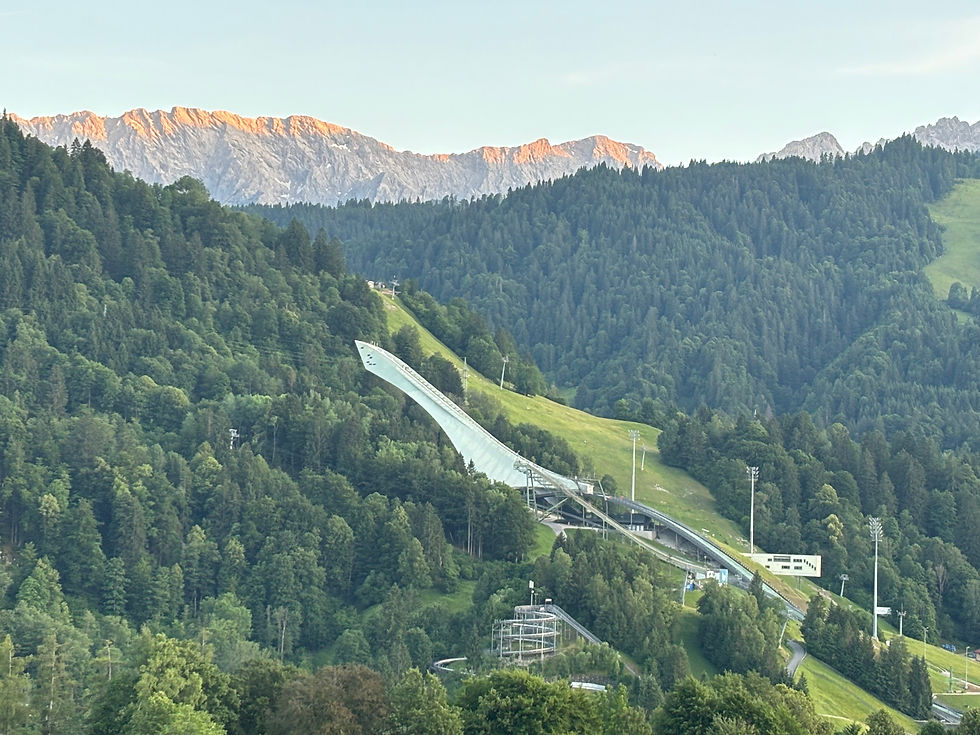
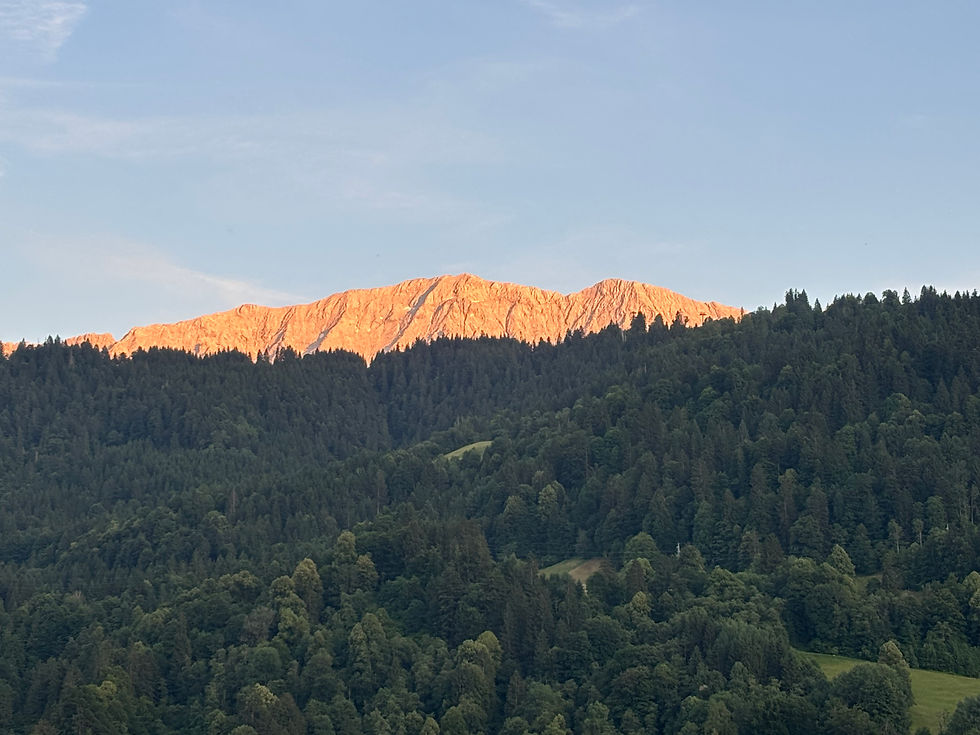

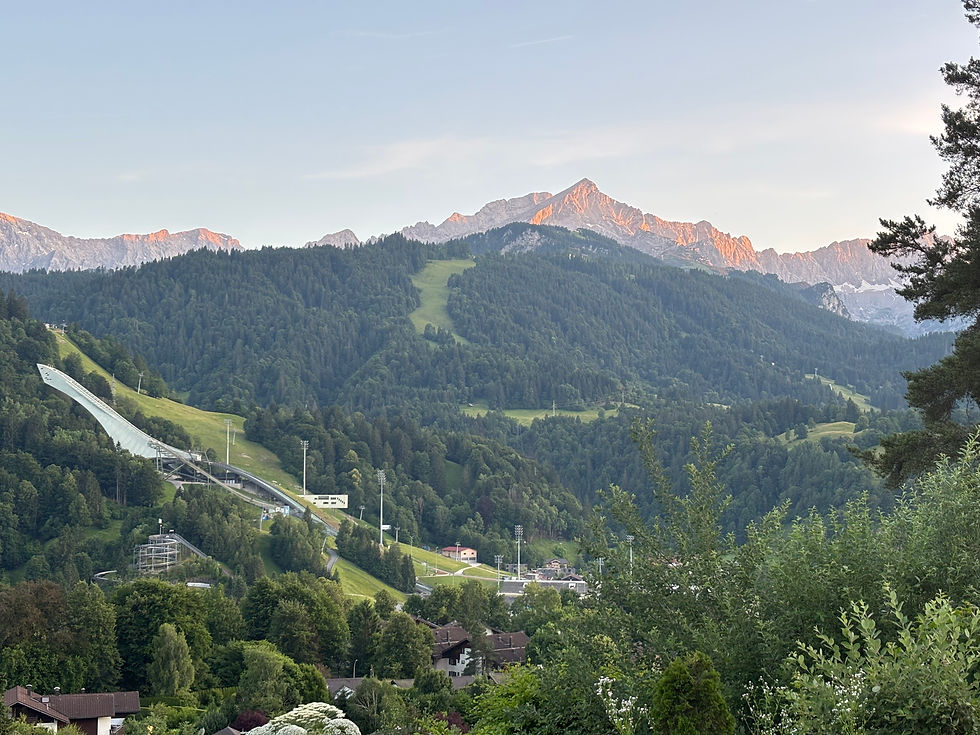
We did get a good recommendation for dinner though: Ristorante Renzo in the town. A very popular place with amazing food and great service. We had 2 Bruschetta, 2 large Pizzas and 2 drinks for 39 euros.


Day 9 Berchtesgaden and Kehlsteinhaus
This morning started with breakfast in the town at The Berge. This boho chic cafe had great vegan choices and fresh juices.







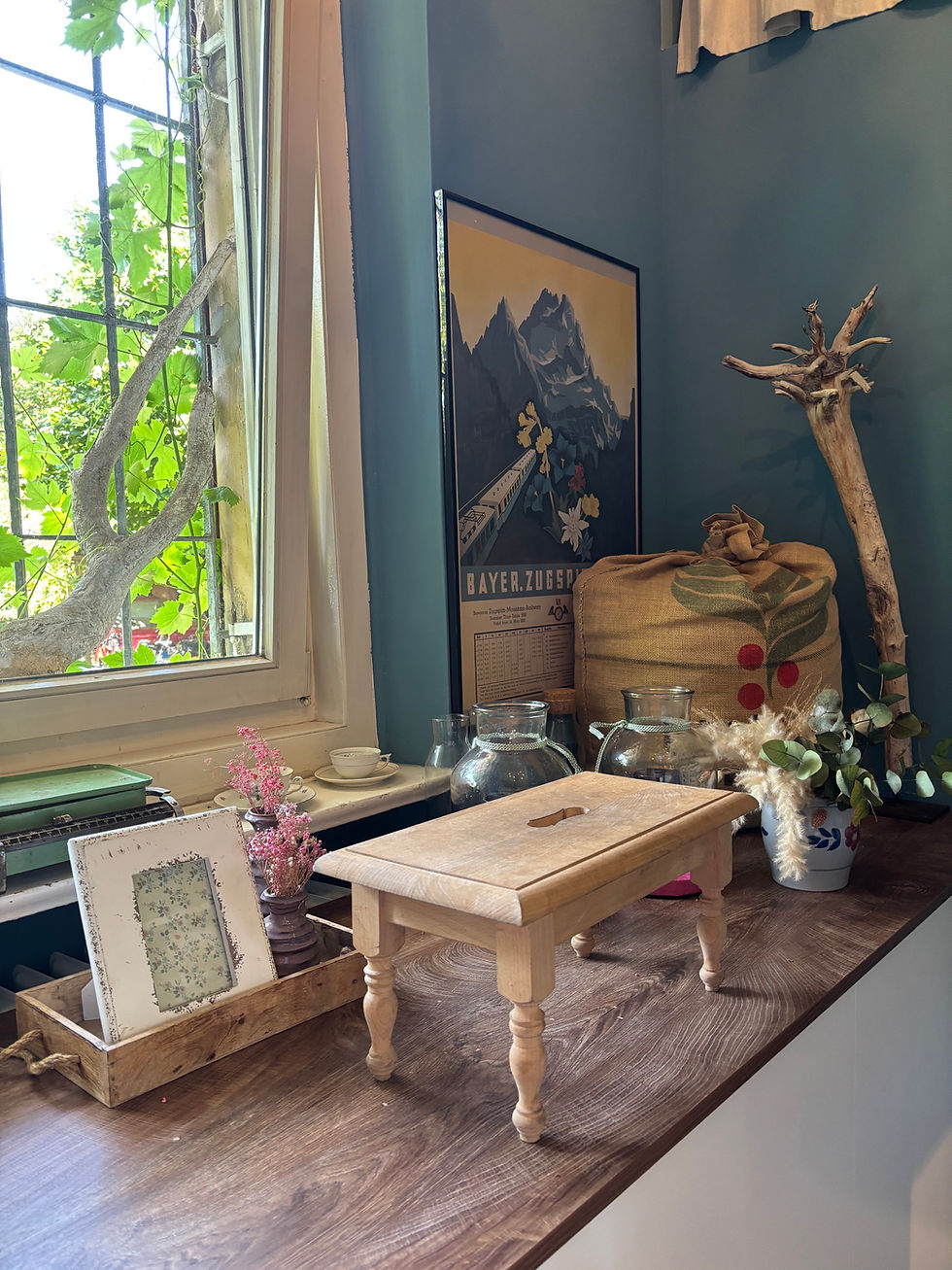
Feeling totally refreshed and full we drove to Berchtesgaden a town in the national park in the south east of Bavaria.

We found ourselves a campsite for 2 nights, Campsite Winkl, which was in a great location and we could use our ACSI membership. It was 27 euros/night plus taxes and electricity costing us 72 euros for 2 nights. The facilities were great, very clean and your stay included free access to all local transport. This was a great way of travelling sustainably so we took a short walk to the bus stop and got the bus into town. It amazed us the number of bikes parked and they would still be there later. The views of the surrounding mountains are stunning especially the Watzmann at 2713m the third highest mountain in Germany.



Day 10 Berchtesgarden and Kehlsteinhaus

Today was very poignant visiting The Kehlsteinhaus aka The Eagles Nest or Hitlers ‘celebrated tearoom’. This house is perched high on the top of Mount Kehlstein at 1834 metres. We used local free transport to and from the pick up point in Berchtesgaden which made this a sustainable travel day.

Looming high above Berchtesgaden this house was built for Hitler to celebrate his 50th birthday and to be used for celebrations and dignitary visits.
The construction of the road which cut a swathe through the sheer rockface took 18 months and the men involved were not allowed any respite even during the severe winter weather. As a result 377 men lost their lives making sure it was ready by 1939 and was completed just before Germany invaded Poland. The house was created to impress and is considered an architectural masterpiece with its brass lined lift buried in the heart of the mountain.
You first approach the house at the tunnel entrance, guarded by two huge brass doors, which was intended to keep the entrance secret. Walking through this first fete of engineering 126m long with perfectly formed blocks of marble you then come to the circular entrance hall housing the lift. The lift is made from polished brass, venetian glass and green leather. It rises 131 metres through the centre of the mountain in a heated lift shaft.

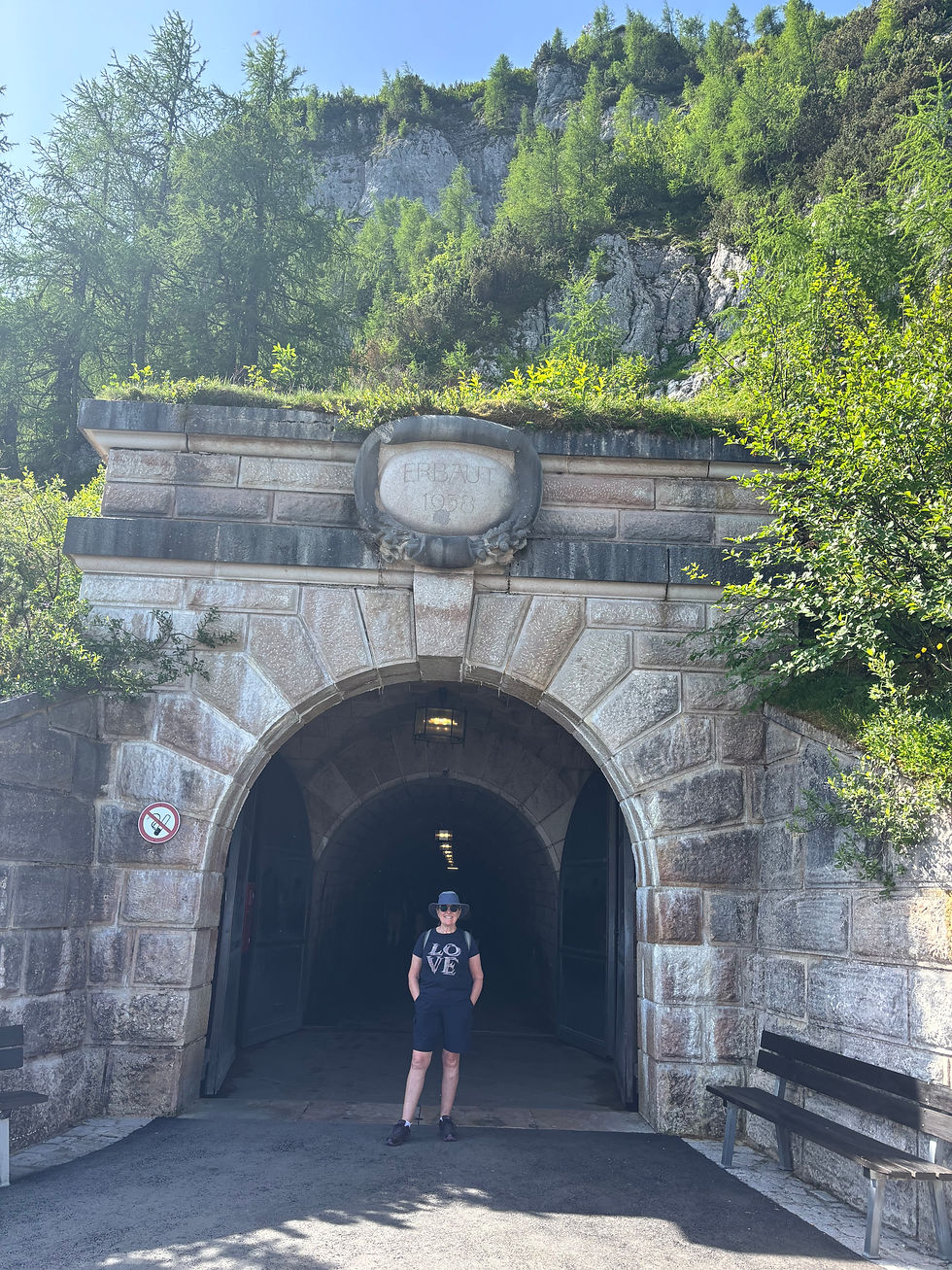

Hitler didn’t visit here many times only on 14 documented occasions as although he used this place to plan his atrocities he was then worried about enemy air attacks. There are records of him being there with Goebbels and Himmler but also the British Prime Minister Neville Chamberlain. The term Eagles Nest came from the RAF and was the code name used for planned air attacks.

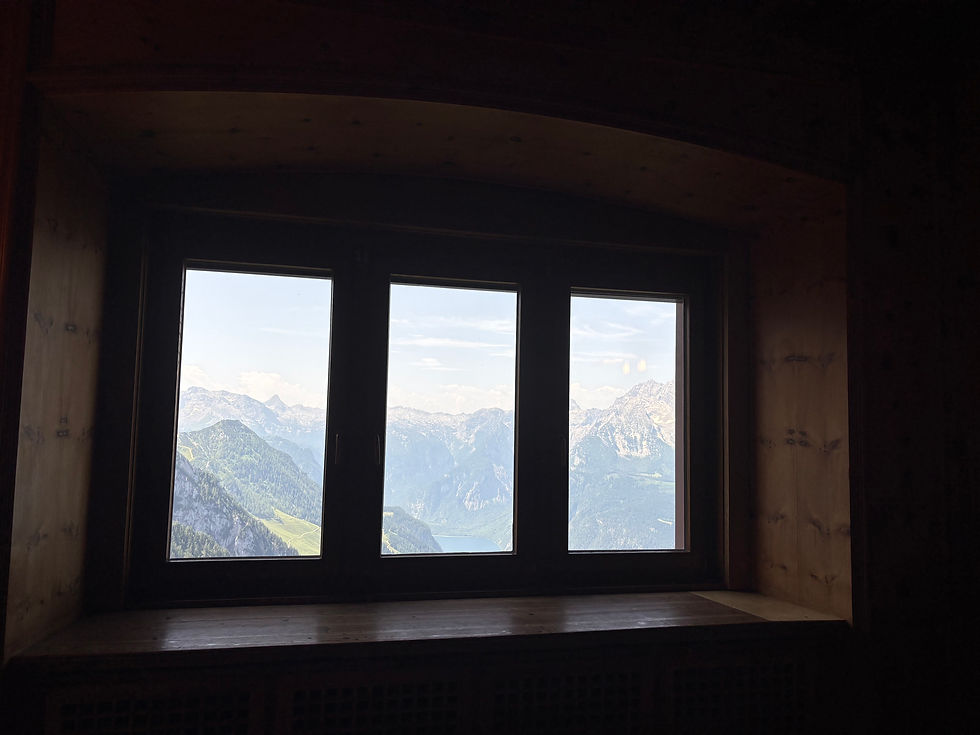


The house survived the war and a local governor petitioned for it to be kept unlike Hitlers other buildings and in 1960 it was donated back to the town of Berchtesgaden now being run by a Trust raising money for charity.
Hitlers main holiday residence, The Berghof, was close by and was blown up 7 years after he died to prevent it becoming a pilgrimage site for Nazi sympathisers.
The tickets for the visit are 36 euros per person and give you a suggested timed visit of 2 hours. This is purely to manage the buses which depart to and from the Obersalzberg. (You get the 838 from Berchtesgaden Bus station). This is the only way to reach the house as no pedestrians are allowed on the road which is a single track. You have plenty of time to have a leisurely lunch and see the house and exhibition. To return to the bus stop at the tunnel you can either walk and traverse the mountain taking 25 minutes or you can go back down the lift and walk through the tunnel taking about 10 minutes. The buses then return you to Obersalzberg where you get a local bus into town or pick up your car. This is very well organised and there is no stampede trying to get a bus as you are allocated a bus in both directions.







Whilst in this area you should take a trip to see one or several of Mad Ludwig's Palaces. The most famous of King Ludwig II is his fairytale castle at Neuschwanstein a real 'Disney' style castle. You can tour the castle but suggest you buy your tickets in advance as in summer they sell out fast. This is definitely on our list to do next time.

Day 11 Seebruck and Ingolstadt
It was a shame to leave Berchetesgaden National Park as we would happily have spent longer there looking around. We did have to start our homeward journey north over the next 3 days to reach Dunkirk for our ferry home. There is a danger at this point of thinking your tour is over and you could miss out mentally on more wonderful parts of your trip.
Driving to Ingolstadt we drove through the charming town of Seebruck and stopped for coffee and lunch. We could have spent longer here in truth.



It was fab driving through different scenery again having been through the vineyards and then mountains we were now in the hops growing region used famously in german beers. We had never seen the vertical growth of the vine hops before and there were acres upon acres in this region.


As we drove through Ingolstadt we saw this great art work on one of the apartment blocks. The building had a fatastic appearance of 3D

.Our stay for the night was in a hotel booked through Booking.com. It was called Roomreich and was an interesting concept. The rooms were very comfortable and clean but very basic. There was again no tea or coffee facilities however when I asked at reception I was given a large flask of hot water to use to make my own coffee. This was perfect.


There was an inside bar/breakfast room area and outdoor covered seating area so we unpacked and took ourselves outside to put our feet up and enjoy the evening sun. The view was nothing to write home about but we were happy. Inside was the best vending machine ever! It was a full bar and so I paid 4.50 euros for a half bottle of perfectly chilled Chardonnay in a glass bottle which came out of the machine like I'd just chosen a bottle of coke! You then helped yourself to a glass from the cabinet, poured and savoured with a few nibbles 👌.



Day 12 Audi Museum and Rothenburg ob der Tauber
Leaving Ingolstadt we took a wrong turn and came upon the immense Audi Headquaters covering 1,000,000m2. It reminded us of the Boots Company Headquarters in Nottingham UK.
It was a Saturday morning so everywhere was very quiet and it was fascinating to see the huge terminal buildings all labelled and the huge numbers of bike parking rows everywhere. It seemed the bikes outnumbered the parking spaces. We then found the Audi Museum which opened in about 15 mins so we parked up as it was too good to miss.

It was 5 euros each to enter this ultra modern circular building arranged over 4 floors to match not only the 4 rings of Audi but also the rings of a tree trunk symbolising duration and change.

You start at the top floor and work your way anticlockwise down the building. The history as well as the cars on display was fascinating.
Audi was found by Horch Head of Motor Vehicle Construction at Benz in 1896. He then set up his own company in 1899 to produce cars but after it becoming a share dealing company in 1904 he had a disagreement with the Supervisory Board and in 1909 they parted ways!
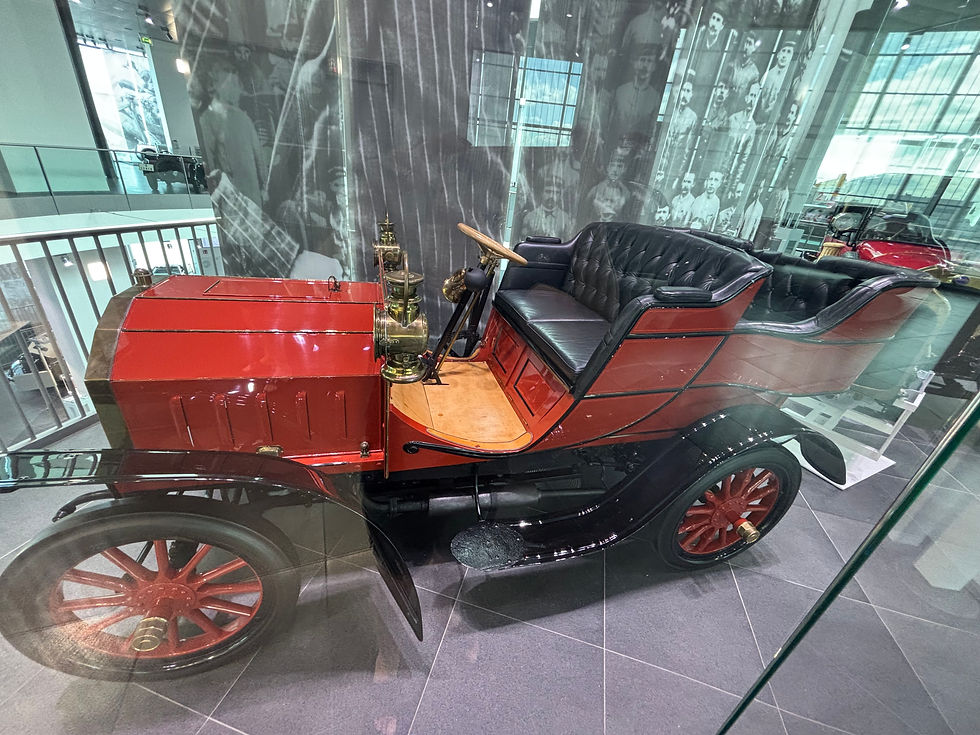
Horch set up another company initially in his own name but due to the similarities with his first company they made him change the name. Horch means to hear in German we were told and so Horch used the Latin of this which is audire (eg aural, audio) and so Audi was formed!
The museum covered the years of development as can be seen on the lights inside the lift and to see how the famous names developed in the car world was brilliant. There was Benz, Daimler, Diesel, Dunlop. There was also a knitting machine factory which started to produce bikes sold under the name NSU from 1892 and then produced a chassis for the Daimler steel wheeled car in 1889.



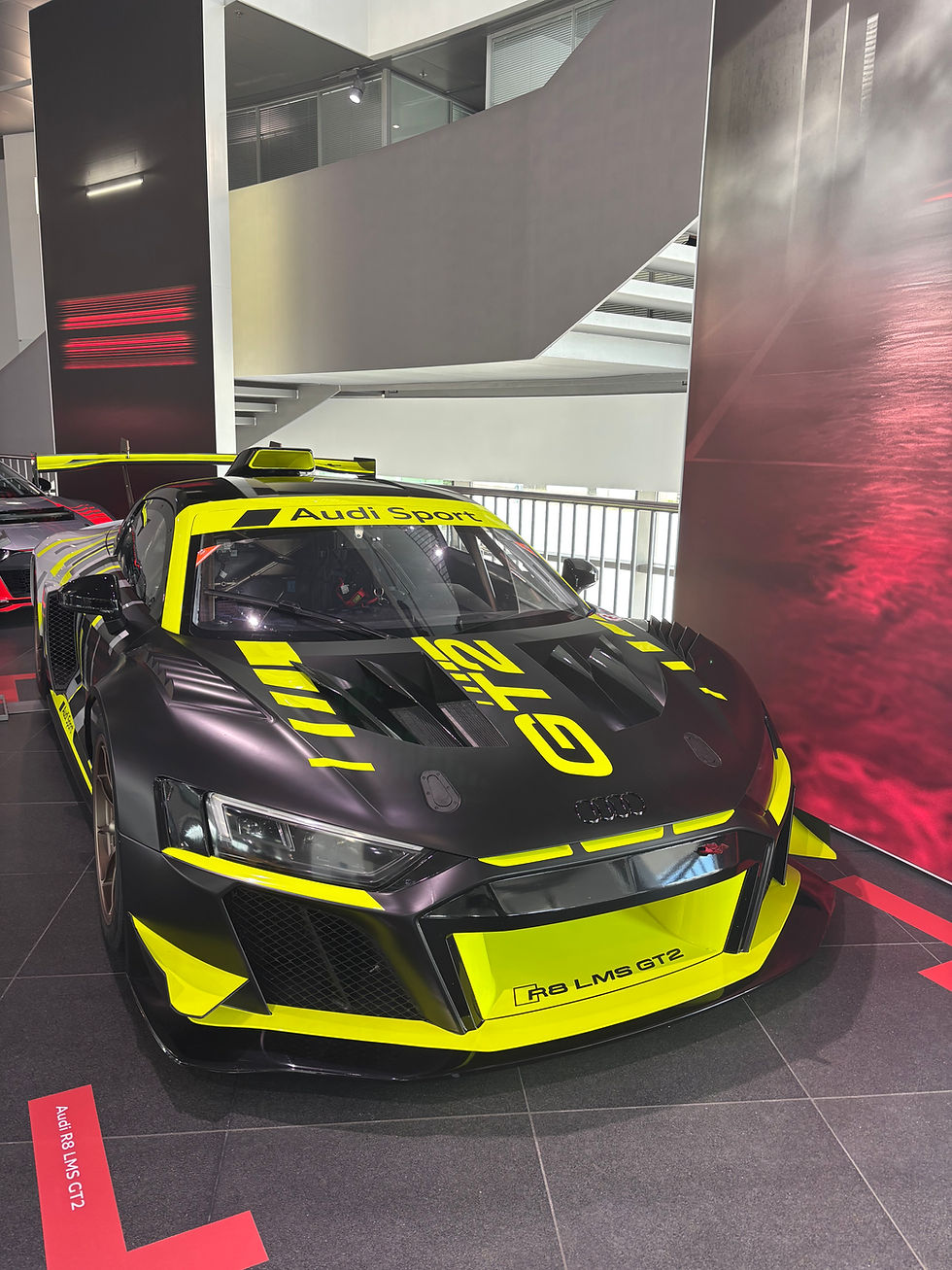
The four rings synonymous with Audi was following the merger of 4 companies namely DKW, AUDI, HORCH, WANDERER

In the afternoon we drove to the picturesque town of Rothenburg ob der Tauber. This town once inspired the Brothers Grim to write their fairytales and you could see why. Strolling through the streets of half wooden medieval houses was magical. It is one of only four towns in Germany with its city walls completely intact. The day we were there there was a 4 day pageant type celebration which meant it was quite busy and we would have preferred a quieter time to really enjoy the buildings and soak up the atmosphere.

We had lunch in a great cafe called Cafe Lebenslust which had several vegan options. Whilst there were lots of indoor seats we chose to sit in the little courtyard at the rear sheltered from the midday sun but enjoying a chilled glass of Sauvignon. The afternoon was topped off by vegan ice cream sat near the fountain.
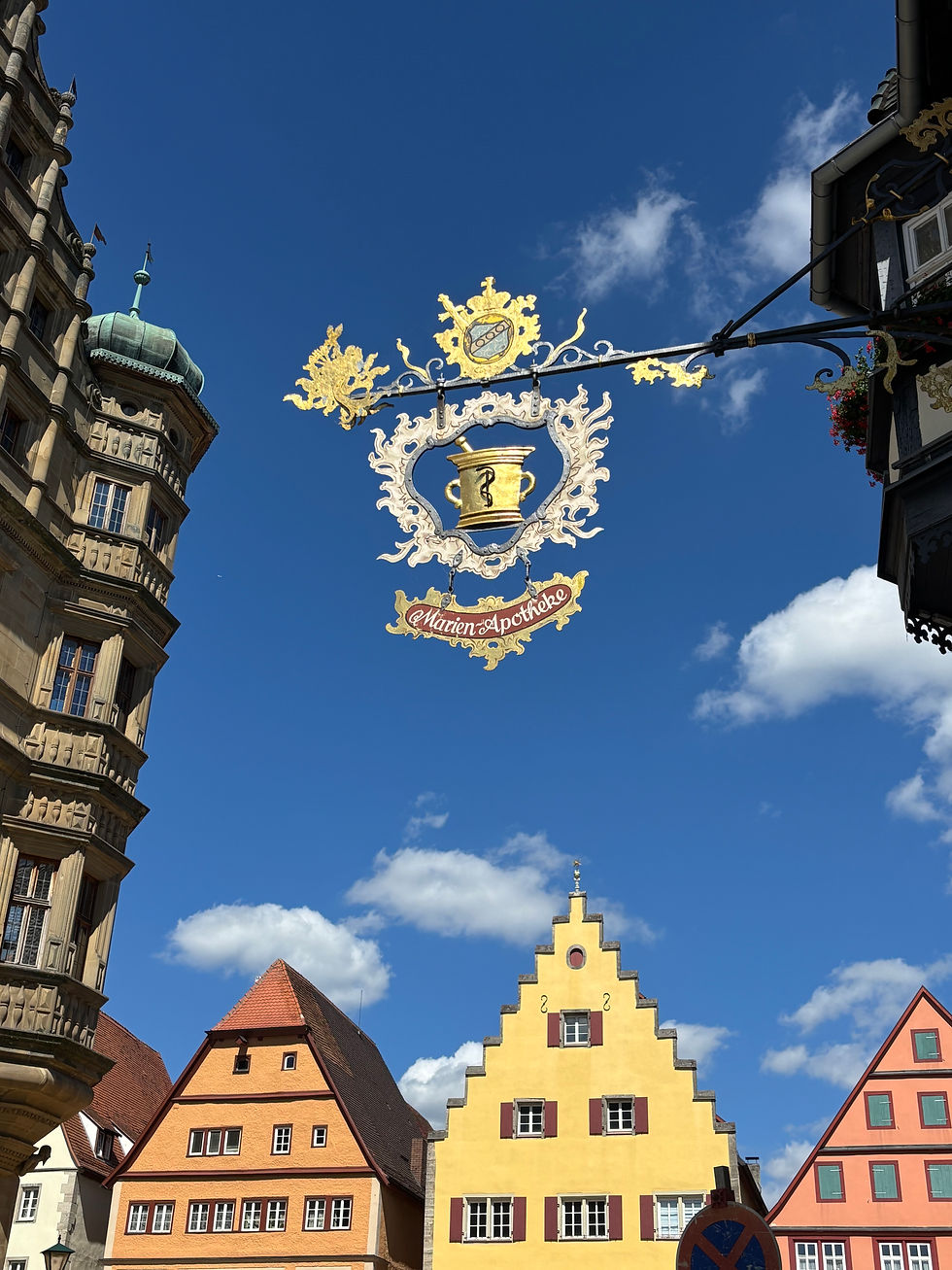



The city walls around Rothenburg date to the 12th century. It is well preserved and encircles the old town. You can walk around the walls and towers to see the panoramic views. The wall is approximately 4 Km in length and has 42 towers plus 6 city gates
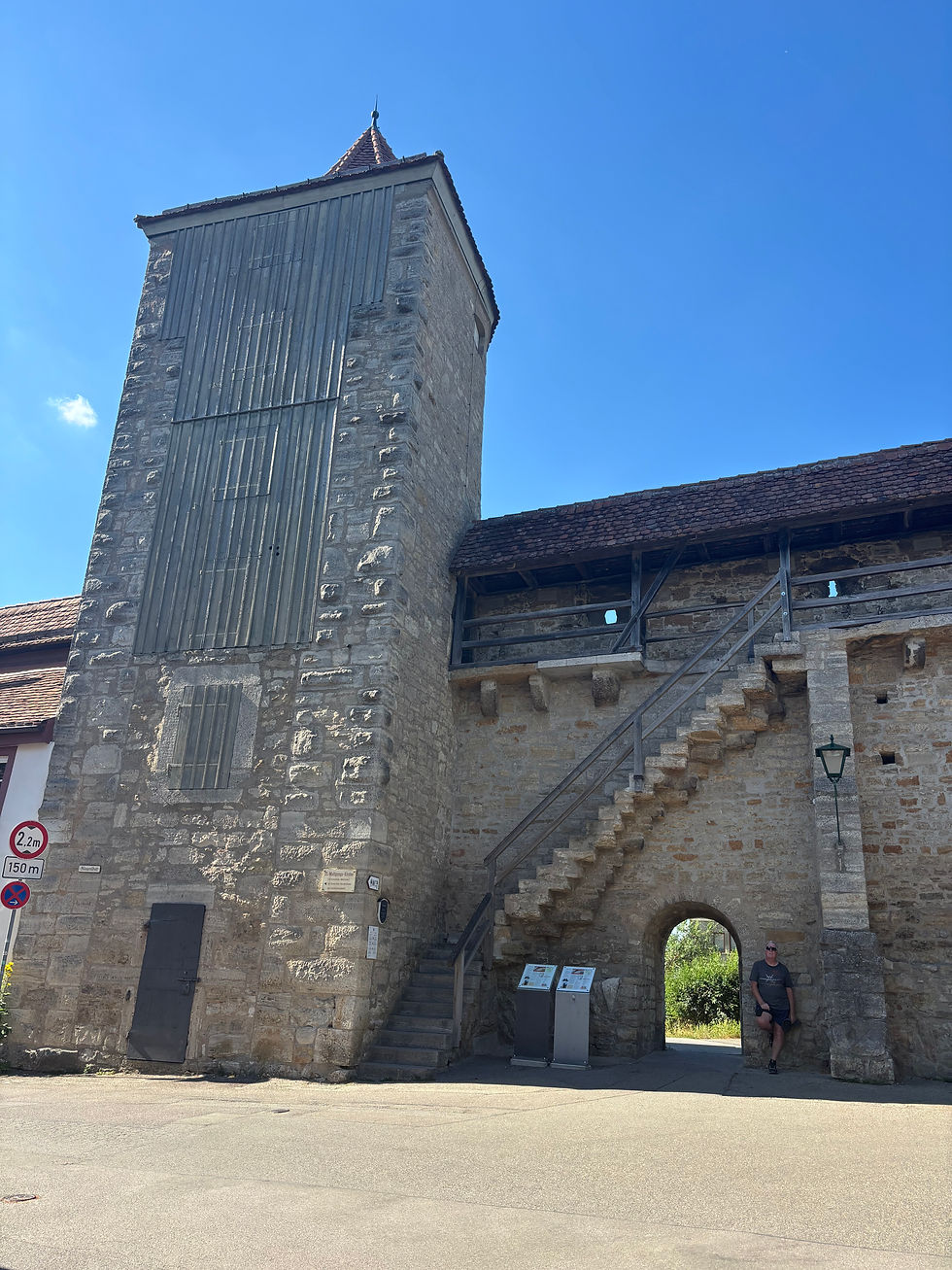

This evening we stayed at another freedom camping spot we found on Park4/Night near to Creglingen

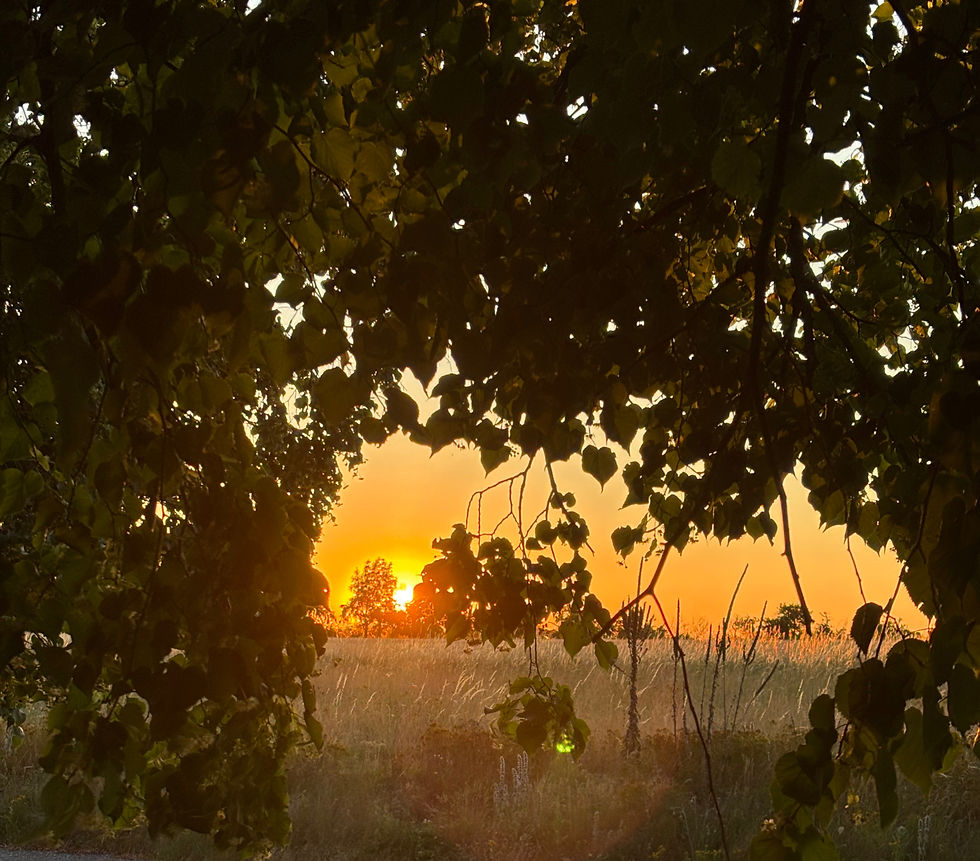

There was only us surrounded by wheat fields, highly scented blossom trees and the buzzing of the bees. The sunset was stunning followed by an equally stunning sunrise and a surprise visit from the local hare.

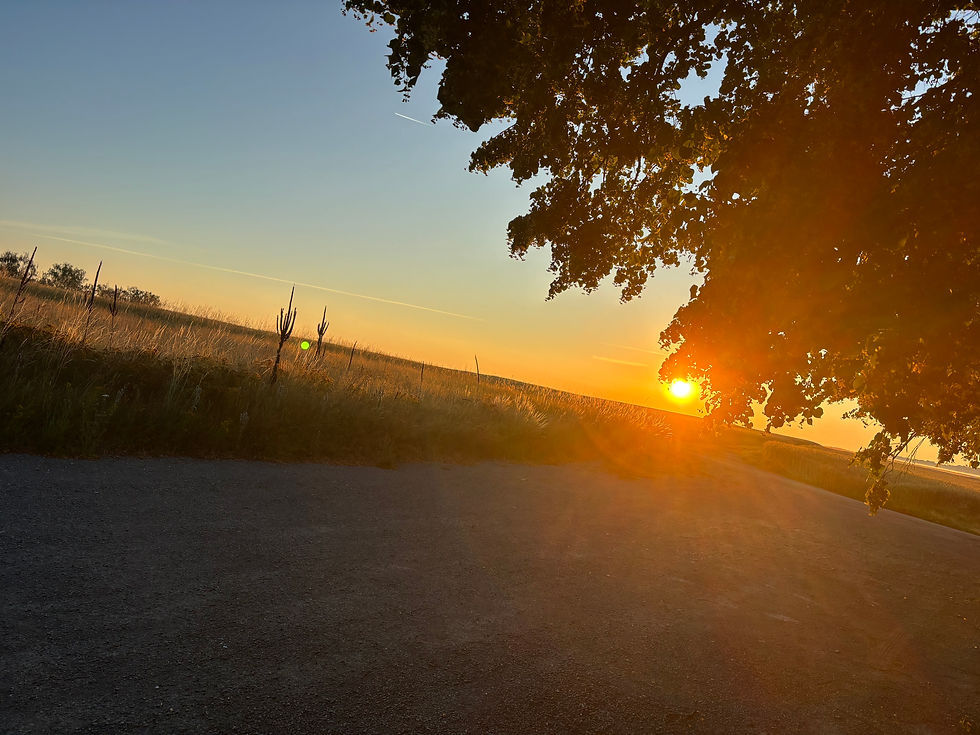
This was definitely a day to remember.
Day 13 Liege
We drove back to Belgium and stayed in Esneux near Liege. This day was mainly travelling until we found our parking spot in a wooded area used by the odd campervan and dog walkers.



What's great about touring and camping is getting to chat to some great people and knowing we touched each other’s lives for a short time which is what it’s all about.
Alex in his camper van worked in Kenya for 6 years and undertook installations for Heineken but no longer in the UK since Brexit and the red tape needed just to account for the tools! Bridget is a mum of 4 and went to Iceland on a budget. She loved to chat as part of her dog walk and spent equally as long talking to Alex. Our paths crossed such a short time but are part of our memories for this little camping spot 🤗
Day 14 Bruges and Dunkirk
As we left Esneux we drove through Liege and had we had more time we would have stopped to explore this town which had plenty to offer.
Unfortunately we need to be back in Dunkirk this evening as our ferry was first thing in the morning back to the UK.
We decided there was nothing we wanted to see in Dunkirk so we headed again for Bruges to have lunch and to strecth our legs.
We found a great place called Kaffee Kamil. The weather was still a strong 30 degrees but on the menu was a vegan chilli and rice which we couldn't pass up. It was so tasty we were so glad we found this little gem of a place and everything was made with love something we say all the time on our bakery market stall!


We then had dessert from Otto Waffles as it would be rude not to 😂

Finding our accommodation for the night in Dunkirk we used Airbnb.com and found an apartment which had good reviews. However, what we got was awful. The apartment block was one of many and it was literally crumbling so much so we could see the rebar where the concrete had fallen off. The building smelt and the apartment was absolutely red hot inside with no way of cooling it down. We literally had to have cold showers and sit in damp towels until the sun set and the room cooled very slightly. We had our own rechargeable fans which were a goddsend over night. Our future tours will not include an overnight stay in Dunkirk that for sure.
Day 15 Dover to Cheshire
As we drove back home we had time to reflect on the highs and lows of our tour. Germany has many beautiful areas and really should be enjoyed in a leisurely way. 14 nights is not enough to travel from the north of England to southern Germany and see everything you want to see.
However, there are highlights we can recommend to you for definite and some to miss out if time is short.
Our highlights include:
Namur Citadel
Allerheiligen Waterfall
Oppenau
Meersburg
Zugspitze
Berchtesgaden
Kehlsteinhaus
Audi Museum
Seebruck
Liege
Bruges
Places we think you can miss:
Bingen
Mainz
Lindau
Dunkirk
We always like to share our costs and facts with you where we can so here goes for 14 nights:
Miles travelled 2379
Steps walked 89,289
Camping 10 nights
Accommodation 4 Nights
Overall Cost £2012
Costs could be reduced in a number of ways if you wanted to do this on a reduced budget for example not staying in paid for accommodation, having meals out or taking the trips up Zugspitze and the Kehlsteinhaus. Overall these things would save you approx 500-600 euros and so the trip fully inclusive of ferry, fuel, food and camping would be an average of 100 euros per day. However, we also think these things made our trip.
So in this blog 'Germany - Unveiling Our True Thoughts and More: Two Weeks of Adventure in Bavaria' we show we had a fantastic look around Germany and wished we had longer as there is so much more to see. We try to share with you the reality of being on the road for a fixed time when you have time commitments elsewhere but if you are not restricted give yourself at least 6 weeks or more to really enjoy all this country has to offer.



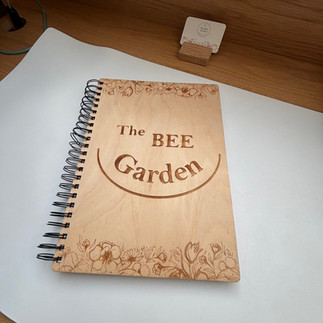

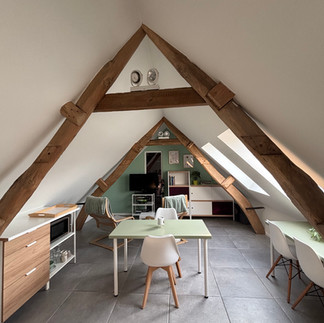

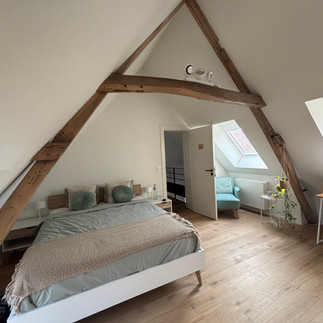



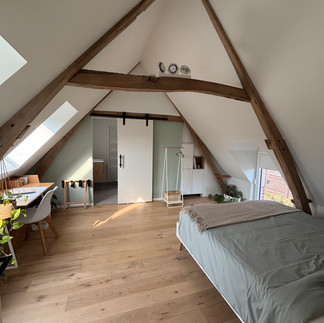

Comments